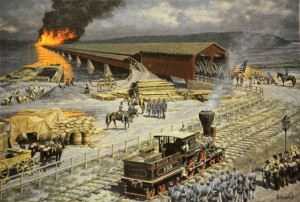By the time of his death in 1885, just 35 days shy of his 60th birthday, Anson Stager had served as the president of several powerful companies: Western Electric, the Chicago Telephone Co. and the Chicago Edison Co.
During the Civil War, the New York-born Stager proved to be an expert on the telegraph key. He was made a colonel in the U.S. Army and appointed supervisor of the U.S. Military Telegraph. As such, he was given the task of developing a telegraphic code that Confederate wiretappers could not decipher. He succeeded, and during the course of the war, more than 1.2 million vital telegrams were sent using Stager’s code.

Union troops gather on the Columbia side of the Susquehanna River as the Columbia/Wrightsville Bridge goes up in flames in 1863. The painting by York artist Bradley Schmehl is part of the Railroad Museum of Pennsylvania's new exhibit, "The Role of Railroads in Pennsylvania During the Civil War." (Blaine Shahan / Lancaster Online) Read more: http://lancasteronline.com/article/local/631205_Exhibit-looks-at-role-of-railroads-in-the-Civil-War.html#ixzz1sfLluu9k
But even before that, in 1846 when the first telegraph line was built connecting Harrisburg and Philadelphia, the telegraph operator chosen to manage Lancaster’s new station was Anson Stager.
Stager’s story is among the many other stories, photos and artifacts on display as the Railroad Museum of Pennsylvania opens its new exhibit, “The Role of Railroads in Pennsylvania During the Civil War.”
Located on the second floor of the museum, the exhibit, which opens Saturday and runs through December, examines the key role the fledgling railroad industry had in America’s first modern war.
During the years 1861 to 1865, railroads, especially those in northern states where rail lines were more modern and more plentiful, carried thousands of troops and millions of tons of ammunition and supplies to battlefronts from Maryland and Virginia to the Mississippi River.
“It was the first war where railroads were actually used as a tactical weapon,” said exhibit curator Andrew J. Etman.
The exhibit includes a piece of the Mt. Wolf covered rail bridge, which was burned by Rebel Gen. Jubal Early in 1863; numerous historic letters, some discussing damage to rail lines and bridges by Confederate raiders; and the iron nameplate of the “Judge Watts” locomotive, which was used during the Antietam campaign of 1862.
“It traveled 74 miles in just under two hours to deliver ammunition to Union troops there,” Etman said.
Also on display is the saddle of Major Gen. John White Geary, who led troops of the Second Division, XII Corps, on Culp’s Hill at Gettysburg, and who would become Pennsylvania’s governor in 1867.
A gleaming brass bell, made around 1860 by McKay and Aldus of Boston, stands in the exhibit. It once adorned one of two engines, either the Arkansas or Nathaniel McKay
Several telegraph keys are on display, including the personal key used by Ten Eyck Hilton Fonda, grandfather of actor Henry Fonda.
On June 30, 1863, Fonda received a message from Harrisburg addressed to Secretary of War Edwin Stanton warning him that the Confederate Army was closing on Gettysburg.
Leaving from Washington, D.C., Fonda rode his horse all night long in order to hand-deliver the message to Union Gen. George Meade, who was 16 miles to the south near Taneytown, Md., at the time.
“This is an opportune time for us to highlight the important part that railroads played, not just in the Civil War, but in all our conflicts, up to this very day,” said museum director Charlie Fox, indicating that 2012 is part of the state’s 150th anniversary commemoration of the war. “Railroads have always been an important part of our national defense. And it all began in the Civil War.”

